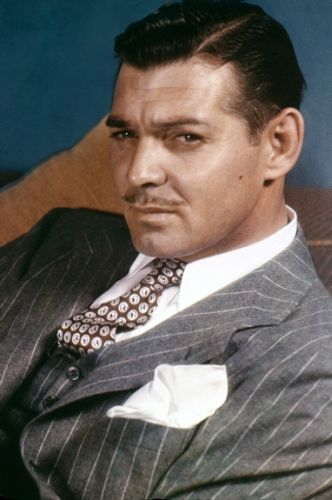Mens Fashion & Style Icons From the 1920’s – 1930’s

Between hitting the pads, swinging idly in the hammocks on Whitsunday Island, I've had plenty of time to catch up on some fashion history. As many of you already know my style inspiration for Hawkins & Shepherd shirts is heavily themed around the pin collar shirts that were massively in vogue in the 1920's to 30's.
I've made a tonne of research notes and stumbled across some devilishly handsome gentlemen that were really stood out from that era. I wanted to share some of those notes with you today.
Robert Montgomery
Robert Montgomery was an American film and television actor, director, and producer. I've included an MGM still and to quote sartorial writer James Sherwood; I 'Love a man who can wear white flannel and a cravat with conviction.'
According to IMDB, in 1935, he became President of the Screen Actors Guild. His stay with MGM lasted 16 years, and was only interrupted by WWII when he joined the navy. He saw action in both Europe and the Pacific.
You'll notice if you Google Robert Montgomery that he wore a lot of suits, with heavy cloth as was typical of the time. But immaculate fit, incredibly suave. He was clearly a man who dressed with the plenty of intent.
Marlene Dietrich
They're not all going to be dudes in this article. It would be utterly remiss of me not to point out the fine splendour of Marlene Dietrich, regarded as the original Flapper. I've taken notes from the wonderful book by Christopher Laverty called Fashion in Film, a derivative from his excellent blog Clothes on Film.
He talks about the costumier Travis Banton who made the suit for Marlene Dietrich's first Hollywood film entitled, Morocco.
'Banton eschewed the era's (1920's - 30's) more obvious glamour to craft a controversial indelible image in the history of cinema. Dietrich plays a nightclub singer Amy Jolly, seen for only the second time wearing white-tie formal attire for men: black tailcoat, black trousers, white wing-collar shirt, white dress waistcoat with white bow tie, white silk pocket square and black top hat.'
I strongly recommend you to all look as closely at the trends in women’s styles as well as men. When I write articles themed around menswear trends, I've always got half an eye on what the women are up to. Especially in this rejuvenated, androgynous-shapeless, gender fluid fashion era, it's a mistake to think that one does not reflect nor inspire the other.
FURTHER NOTES
Whilst trawling through the glorious 'A History of Fashion' by J.Anderson Black and Madge Garland I thought this was worthy of note.
'The most important item of the new style was the width of the grey flannel trousers, or 'Oxford bags' as these large garments were called since they had been launched by some under graduates of Oxford University'.
Clark Gable
Clark Gable was very much the George Clooney of his day. Just look at the supreme collar fit on his shirt, perfectly angular for his dimpled chin.
According to an excellent article by Vintage Dancer 'Most collars were 3 or 3.25 inches long but could extend down 5 inches. Clark Gable wore the 4.5 to 5 inch California collar in a few of his movies.'
His most recognised films are Mutiny on the Bounty, It Happened one Night and of course Gone with the Wind.
Before the Second World War would eliminate an entire clientele of Savile Row customers, the three main houses Anderson & Shepherd, Huntsman and Kilgour, French & Stanbury would have more than likely provided the suits for Gable, much like they did for Valentino, Astaire, Chaplin and Grant.
Fred Astaire
King of the White Tie and just an incredible dancer. I love the quote that Gene Kelly gave about Fred Astaire as being "the only one of today's dancers who will be remembered."
According to linear notes in Savile Row, by James Sherwood, the earliest record of Astaire on the Row is in Anderson & Sheppard's 1923 ledger. His style has been immortalised in modern day trail blazers such as the late Tommy Nutter and his former partner Edward Sexton.
For further reading you can catch the wonderful article by Gentleman's Gazette on the life, times and style of Fred Astaire. They go into fantastic detail about his tailcoats and reference his style ambivalences in his autobiography Astaire, Steps in Time: “At the risk of disillusionment, I must admit that I don’t like top hats, white ties and tails.”
Gary Cooper
Remarkably the long read of Gary Cooper on Wikipedia mentions very little of his personal style. By all accounts he wasn't much of a conversationalist. But his style spoke volumes. Like many of his leading men contemporaries of the time, Cooper got his suits tailored at Anderson & Sheppard.
Post war Cooper would change allegiance to fellow Savile Row tailor Norton & Sons. His films of not would be the aforementioned Morocco, A Farewell to Arms, (he was good friends with Hemingway) and The Wedding Night.
I've found a wonderful quote on the Gary Cooper website that characterises my thoughts on the man. 'No matter what costume he put on, he looked like he owned it. The camera loved him, and so did the box office.'
Founder of this eponymous blog, focusing on men's fashion & lifestyle.











